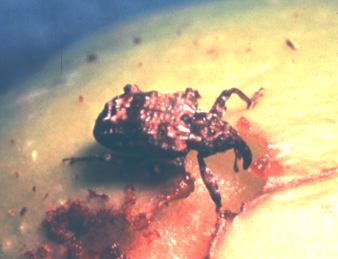 Plum Curculio, Conotrachelus nenuphar
(Herbst) in Blueberry
Plum Curculio, Conotrachelus nenuphar
(Herbst) in BlueberryBiology: Usually thought of as apple,
peach and plum pest but also on blueberry, huckleberry, grape,
persimmon and cherry (Milholland & Meyer 1984). One of the
most potentially damaging pests during the petal fall period.
Life cycle covered in apple section. Adults become active when
average daily temperatures near 10-15oC (50-60oF) for 3-4 2 or
more consecutive days and high temperatures are 24oC (75oF) for
2 or more consecutive days (Milholland & Meyer 1984). Often
active when early varieties beginning to bloom (Marucci 1966).
Female oviposits in fruit, leaving crescent-shaped scar. Larvae
develop in fruit, over about a 2-week period. Infested berries
turn blue prematurely, often dropping to ground before
uninfested berries turn blue. A few late-maturing larvae may
reach market (Marucci 1966). Most of the adults produced enter
diapause, but a few mate and produce a second generation (Mampe
& Neunzig 1967). Reissig et al. (1998) reported that injury
progressed faster and ended earlier in smaller apple trees than
larger trees, probably because of differences in tree
architecture; this may relate also to a relatively small host
plant as blueberry.
A note on plum curculio strains. There are two strains of plum
curculio. The northern strain has an obligatory chilling
requirement. Therefore there is a single generation per season.
The southern strain lacks this chilling requirement and can
develop two generations seasonally. A rough
map showing the distribution of the northern
(single-brooded) and southern (double-brooded) strains was
developed by Chapman (1938). There are genetic differences
among geographic strains of PC (Zhang et al. 2008).
Furthermore, there are Wolbachia
symbionts in PC, also with geographical differences in
their genetics (Zhang et al. 2010). These differences in Wobachia infections likely
result in observed differences to mate within and among PC
strains (Zhang and Pfeiffer 2008).
Monitoring: Shake branches over a sheet. Examine fruit for fresh injury, especially on borders adjacent to woodlands.
Control: Two applications of a contact insecticide usually necessary (Milholland & Meyer 1984); first when adults begin to return to field; second timed to end of migration period, when max. temps. reach 32oC (90oF) (Milholland & Meyer 1984). Imidan is very effective.
Additional Reading: